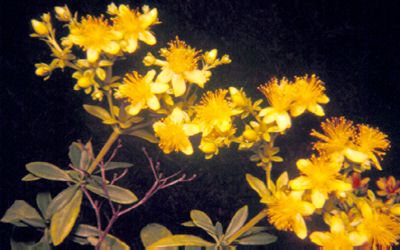Genus: Hypericum

Taken by G. A. Kalmbacher, 1961.
Nomenclature
Hypericum L., Sp. Pl. 2: 783. 1753. Gen. Pl. 341. 1754. LECTOTYPE: Hypericum perforatum L., designated by Britton & Brown (1913).Ascyrum L., Sp. Pl. 787. 1753. Gen. pl., ed. 5, 342. 1754. Hypericoides Adans., Fam. Pl. (Adanson) 2: 443. 1763. Myriandra Spach, Ann. Sci. Nat. Bot. ser. 2, 5: 364. 1836. LECTOTYPE: Hypericum hypericoides (L.) Crantz (Ascyrum hypericoides L.), designated by Britton & Brown (1913).
Brathys L. f., Suppl. Pl. 43, 268. 1782. TYPE: Brathys juniperina L.f.
Crookea Small, Fl. S.E. U.S. 786, 1335. 1903. TYPE: Crookea microsepalum (Torr. et A. Gray) Small.
Key to the species of Hypericum
(Woody spp. only)
1. Petals 4; sepals 4, very unequal, the outermost much larger that the 2 innermost...2
1. Petals 5 or rarely 4; sepals 5, equal to subequal, sometimes with 1 sepal conspicuously larger than the rest...3
2. Decumbent; styles 2; stamens fewer than 50; leaves less than 7 mm wide...Hypericum hypericoides
2. Erect; styles 3 or 4; stamens 50-100; leaves more than 7 mm...Hypericum crux-andreae
3. Sepals narrowly oblong, 4-6 mm long, 1-1.5 mm wide, acute; leaves oblanceolate to elliptic 2-4 cm long, 2-6 mm wide; capsules ovoid, acute, 3 mm wide...Hypericum densiflorum
3. Sepals ovate, elliptic, or foliaceous, more than 2 mm long; leaves usually more than 1 cm wide...Hypericum prolificum
List of Hypericum Species
References to Hypericum
- Adams, P. 1973. Clusiaceae of the southeastern United States. J. Elisha Mitchell Sci. Soc. 89: 62-71.
- Adams, W. P. 1957. A revision of the genus Ascyrum (Hypericaceae). Rhodora 59(700): 73-95.
- Adams, W. P.; Robson, N. K. 1961. A re-evaluation of the generic status of Ascyrum and Crookea (Guttiferaceae). Rhodora 63: 10-16.
- Adams, W. P.; Robson, N. K. 1961. A re-evaluation of the generic status of Ascryrum and Crookea (Guttiferacae). Rhodora 63: 10-16.
- Allison, J. R. 2011. Synopsis of the Hypericum denticulatum complex (Hypericaceae). Castanea 76: 99-115.
- Barcaccia, G. et.al. 2006. Genetic diversity and reproductive biology in ecotypes of the facultative apomict Hypericum perforatum L. Heredity 96: 322-334.
- Bartholomew, E. A. 1950. The family Hypericaceae of West Virginia. Castanea 15: 102-9.
- Bosy, J. L.; Reader, R. J. 1995. Mechanisms underlying the suppression of forb seedling emergence by grass (Poa pratensis) litter. Funct. Ecol. 9: 635-639.
- Britton, Nathaniel L. 1890. New or noteworthy North American phanerogams. III. Bull. Torrey Bot. Club 17: 310-6.
- Cooperrider, T. S. 1989. The Clusiaceae of Ohio. Castanea 54: 1-11.
- Coulter, J. M. 1886. Revision of the North American Hypericaceae. Bot. Gaz. 11: 80-1.
- Crompton, C. W. et.al. 1988. The biology of Canadian weeds. 83. Hypericum perforatum L. Canad. J. Pl. Sci. 68: 149-162.
- Fernald, M. L. 1936. Plants of the Outer Coastal Plain of Virginia. Rhodora 38: 376-404,414-52.
- Fernald, M. L. 1936. The varieties of Ascyrum hypericoides. Rhodora 38: 430-3.
- Fernald, M. L.; Schubert, B. G. 1948. Studies of American types in British herbaria. Rhodora 50: 149-76, 181-208, 217-33.
- Gillet, J. M.; Robson, N. K. B. 1959. The St. John's worts of Canada. Natl. Mus. Canad. Nat. Sci. Publ. Bot. 11: 1-end.
- Hoar, C. S.; Haertl, E. J. 1932. Meiosis in the genus Hypericum. Bot. Gaz. 93: 197-204.
- Maffi, L. et.al. 2004. Morphology and development of secretory structures in Hypericum-perforatum and H. richeri. Nordic J. Bot. 23: 453-461.
- Merriam, J. S. 1870. Ascyrum crux-andreae. Bull. Torrey Bot. Club 1: 44.
- Nurk, N. M.; Blattner, F. R. 2010. Cladistic analysis of morphological characters in Hypericum (Hypericaceae). Taxon 59: 1495-1507.
- Perez-Garcia, F. et.al. 2006. Hypericum perforatum L. seed germination: interpopulation variationand effect of light, temperature, presowing treatments and seed desiccation. Genetic Resources and Crop Evolution 53: 1187-1198.
- Robson, N. K. B. 1981. Studies in the genus Hypericum L. (Guttiferae): 2. Characters of the genus. Bull. Nat. Hist. Museum Bot. 8(2): 55-226.
- Robson, N. K. B. 1977. Studies in the genus Hypericum L. (Guttiferae): 1. Infrageneric classification. Bull. Nat. Hist. Museum Bot. 5(6): 291-355.
- Robson, N. K. B. 1972. Evolutionary recall in Hypericum Guttiferae? Trans. & Proc. Bot. Soc. Edinburgh 41(3): 365-83.
- Robson, N. K. B. 1996. Studies in the genus Hypericum L. (Guttiferae) 6. Sections 20. Myriandra to 28. Elodes. Bull. Nat. Hist. Museum Bot. 26: 75-217.
- Robson, N. K. B. 2001. Studies in the genus Hypericum L. (Guttiferae) 4(1). Sections 7. Roscyna to 9. Hypericum sensu lato (part 1). Bull. Nat. Hist. Museum Bot. 31: 37-88.
- Robson, N. K. B. 2002. Studies in the genus Hypericum L. (Guttiferae) 4(2). Section 9. Hypericum sensu lato (part 2): subsection 1. Hypericum series 1. Hypericum. Bull. Nat. Hist. Museum Bot. 32: 61-123.
- Robson, N. K. B.; Adams, P. 1968. Chromosome numbers in Hypericum and related genera. Brittonia 20(2): 95-106.
- Svenson, H. K. 1940. Plants of the southern United States. III. Woody species of Hypericum. Rhodora 42: 8-19.
- Svenson, H. K. 1952. What is Hypericum prolificum? Rhodora 54(644): 205-7.
- Vestal, P. A. 1937. The significance of comparative anatomy in establishing the relationship of the Hypericaceae to the Guttiferae and their allies. Philipp. J. Sci. 64: 199-256.
- Wood, C. E.; Adams, P. 1976. The genera of Guttiferae (Clusiaceae) in the southeastern United States. J. Arnold Arbor. 57: 74-90.
- Zika, P. F. 2003. Notes on the provenance of some eastern wetland species disjunct in western North America. J. Torrey Bot. Soc. 130: 43-46.